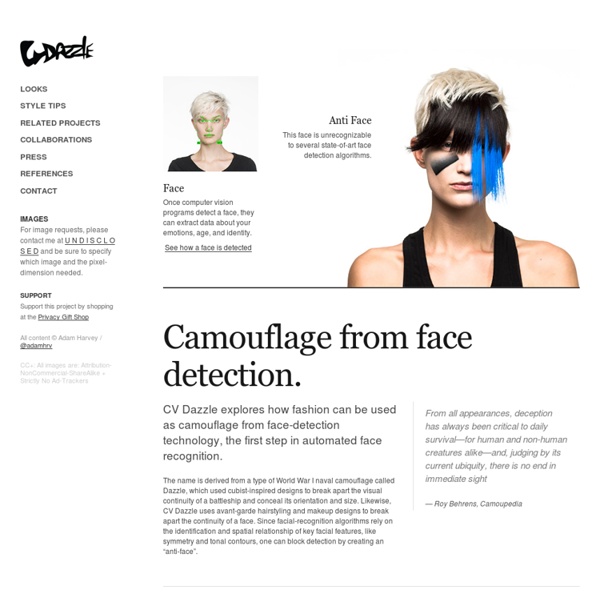



VentureBeat: How to fool facial recognition technology? The day when you’ll be able to hold up your phone and identify a stranger through a viewfinder is getting closer. Google’s Goggles, a mobile app for visual search, has a facial recognition version unreleased to the public, while Israeli startup Face.com’s technology can tag people’s faces in Facebook photos. Facebook even released a basic version of face detection last night, although it doesn’t have recognition. So in a world where technology chips away at our ability to remain anonymous, how does one reclaim some semblance of control? It turns out there’s actually a pretty simple way around the facial recognition technology available in the market today, according to Adam Harvey, a graduate student at NYU’s ITP (the same program that produced Foursquare chief executive Dennis Crowley and that Twitter’s location guru Raffi Krikorian taught at). “It breaks apart the gestalt of the face,” he said. Harvey says there a couple of projects that could stem from idea.
hellais/ooni-probe How to reduce the file size of a PNG file PNG files are lossless compressed bitmapped images. While they are compressed, they can still attain large file sizes depending on the type of image data saved—they are best suited for images with large areas of solid colours and defined boundaries (such as logos). Unlike JPG files, they are not especially suited for storing photographic image data. Compression Tools Edit Lossy Edit Biggest savings can be achieved at a cost of reducing image quality a little: TinyPNG online tool that uses lossy compression to reduce the file size of PNG images ImageAlpha Mac tool that can reduce PNG files using pngquant, pngnq and posterization. Lossless These tools don't lose any quality, they only re-compress images and remove invisible metadata: ImageOptim is a Mac based only image compressor PNGGauntlet is a Windows PNG image compressor Trimage is a Linux based image compressorPngcrush is a command-line application that reduces the size of PNG files losslessly. See Also
What Petraeus and Broadwell could have used instead of Gmail If there's a lesson for cheating spouses to be learned from the Broadwell-Petraeus-Allen-Kelley scandal, it's to think twice before you press "send." The affair between former CIA director David H. Petraeus and his biographer, Paula Broadwell, was uncovered when Petraeus's friend Jill Kelley complained to the FBI that she was receiving harassing e-mails. During the investigation, the FBI began digging through Broadwell's e-mails. General David Petraeus shakes hands with Paula Broadwell. (ISAF via Reuters) Now, the FBI has uncovered between 20,000 and 30,000 pages of documents — most of them e-mails — that contain “potentially inappropriate” communication between Gen. Petraeus and Broadwell were apparently communicating by composing messages and then leaving them in a draft folder for the other to find, making the e-mails harder to trace. The FBI was able to track down Broadwell through the couple's anonymous Gmail accounts, despite the draft-saving technique the two used.
Classroom 2.0 Blink! - Log in to Your PC by Simply Looking at It! Logging into Windows has never been easier! Simply look into your webcam and you’ll be logged into your account in the blink of an eye. Blink! employs advanced face recognition technologies to provide automatic, quick and reliable login for one, or multiple, computer users. Reliable Login under Varying Conditions With Blink! New Haircut? Advanced biometric identification algorithms used in Blink! Improved Security Say goodbye to those long, complex passwords demanded by your corporate security policy. Catch Identity Thieves Blink! Guaranteed for 90 Days – or Your Money Back Blink! Get Luxand Blink! Luxand Blink! For more information read the on-line documentation. Try Luxand Blink! Blink!
Free Keylogger | spyrix.com From the childhood we have been taught that spying is bad. But is it so? If we are talking about information security of your company or your family you will agree that the end justifies the means. Nowadays, in time of rapidly developing information technology we confide information to the computer using it as a storage for commercial and personal data, for communication, shopping, etc. Of course many asked themselves: How safe is it? In opinion of experts in the field of information security the human factor takes a great place, despite the importance of protection against external influence from different malicious software. No anti-virus software will protect you if your employee suddenly decides to send an e-mail or write important business data to his removable device for the purpose of steal. But not all is bad; you just need to supplement your operating system with additional software like . Program Name Spyrix Free Keylogger Version Operating Systems Byte Size Category Type License
Syntactic Bay Leaves - Determining image similarity When I saw this question on stackoverflow asking about how to determine if an image is identical, it reminded me of my favorite class at JHU, Computer Vision. One of the things that I remember is that if you wanted to compute how similar two images are, you’d treat their pixels as vectors, normalize them, then take their dot product. The result is a float between 0 and 1 that indicated the percent similarity of the two images. This process is called the normalized cross correlation. import Image from numpy import average, linalg, dot import sys images = sys.argv[1:3] vectors = [] norms = [] for image in images: vector = [] for pixel_tuple in Image.open(image).getdata(): vector.append(average(pixel_tuple)) vectors.append(vector) norms.append(linalg.norm(vector, 2)) a, b = vectors a_norm, b_norm = norms print dot(a / a_norm, b / b_norm)
CV Dazzle: Open-Source Camouflage From Computer Vision by Adam Harvey by sirchamallow Nov 4